Regulation of anterior/posterior patterning of the axial skeleton by growth/differentiation factor 11 (original) (raw)
- Letter
- Published: July 1999
Nature Genetics volume 22, pages 260–264 (1999)Cite this article
- 4154 Accesses
- 417 Citations
- 13 Altmetric
- Metrics details
Abstract
The bones that comprise the axial skeleton have distinct morphological features characteristic of their positions along the anterior/posterior axis. We previously described a novel TGF-β family member, myostatin (encoded by the gene Mstn, formerly Gdf8), that has an essential role in regulating skeletal muscle mass1. We also identified a gene related to Mstn by low-stringency screening1. While the work described here was being completed, the cloning of this gene, designated Gdf11 (also called Bmp11), was also reported by other groups2,3. Here we show that Gdf11, a new transforming growth factor β (TGFβ) superfamily member, has an important role in establishing this skeletal pattern. During early mouse embryogenesis, Gdf11 is expressed in the primitive streak and tail bud regions, which are sites where new mesodermal cells are generated. Homozygous mutant mice carrying a targeted deletion of Gdf11 exhibit anteriorly directed homeotic transformations throughout the axial skeleton and posterior displacement of the hindlimbs. The effect of the mutation is dose dependent, as Gdf11 +/– mice have a milder phenotype than Gdf11 –/– mice. Mutant embryos show alterations in patterns of Hox gene expression, suggesting that Gdf11 acts upstream of the Hox genes. Our findings suggest that Gdf11 is a secreted signal that acts globally to specify positional identity along the anterior/posterior axis.
This is a preview of subscription content, access via your institution
Access options
Subscribe to this journal
Receive 12 print issues and online access
$209.00 per year
only $17.42 per issue
Buy this article
- Purchase on SpringerLink
- Instant access to full article PDF
Prices may be subject to local taxes which are calculated during checkout
Additional access options:
Figure 1: Expression of Gdf11 in mouse embryos.
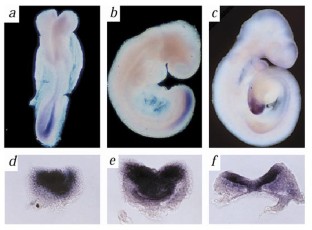
Figure 2: Construction of Gdf11 –/– mice by homologous targeting.
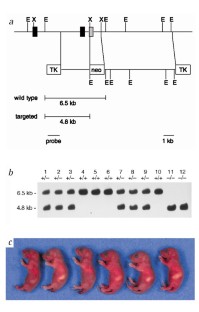
Figure 3: Homeotic transformations in Gdf11 –/– mice.
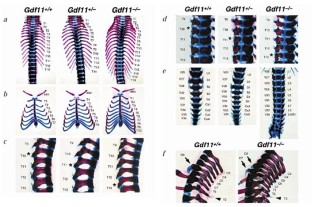
Figure 4: Hindlimb position and somite numbers.
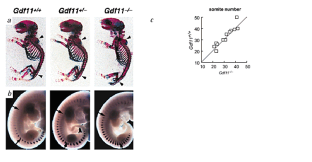
Figure 5: Expression of Hox genes in Gdf11+/+ ( a,c,e,g,i,k,m) and Gdf11 –/– (b,d, f,h,j,l,n) embryos.
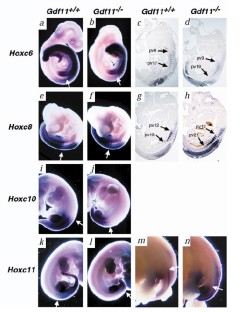
Similar content being viewed by others
References
- McPherron, A.C., Lawler, A.M. & Lee, S.-J. Regulation of skeletal muscle mass in mice by a new TGF-β superfamily member. Nature 387, 83– 90 (1997).
Article CAS Google Scholar - Gamer, L.W. et al. A novel BMP expressed in developing mouse limb, spinal cord, and tail bud is a potent mesoderm inducer in Xenopus embryos. Dev. Biol. 80, 222–232 ( 1999).
Article Google Scholar - Nakashima, M., Toyono, T., Akamine, A. & Joyner, A. Expression of growth/differentiation factor 11, a new member of the BMP/TGF-β superfamily during mouse embryogenesis. Mech. Dev. 80, 185–189 (1999).
Article CAS Google Scholar - Tam, P.P.L. & Tan, S.-S. The somitogenetic potential of cells in the primitive streak and the tail bud of the organogenesis-stage mouse embryo. Development 115, 703– 715 (1992).
CAS PubMed Google Scholar - Capecchi, M.R. Hox genes and mammalian development. Cold Spring Harb. Symp. Quant. Biol. 62, 273–281 ( 1997).
Article CAS Google Scholar - Favier, B. & Dollé, P. Developmental functions of mammalian Hox genes. Mol. Hum. Reprod. 3, 115–131 (1997).
Article CAS Google Scholar - Mark, M., Rijli, F.M. & Chambon, P. Homeobox genes in embryogenesis and pathogenesis. Pediatr. Res. 42, 421–429 (1997).
Article CAS Google Scholar - Oh, S.P. & Li, E. The signaling pathway mediated by the type IIB activin receptor controls axial patterning and lateral asymmetry in the mouse. Genes Dev. 11, 1812– 1826 (1997).
Article CAS Google Scholar - Durston, A.J., van der Wees, J., Pijnappel, W.W.M., Schilthuis, J.G. & Godsave, S.F. Retinoid signalling and axial patterning during early vertebrate embryogenesis. Cell. Mol. Life Sci. 53, 339–349 (1997).
Article CAS Google Scholar - Lee, S.-J. Identification of a novel member of the transforming growth factor-β superfamily. Mol. Endocrinol. 4, 1034– 1040 (1990).
Article CAS Google Scholar - Wilkinson, D.G. Whole mount in situ hybridization of vertebrate embryos. in In Situ Hybridization: A Practical Approach (ed. Wilkinson, D.G.) 75–83 (IRL Press, Oxford, 1992).
Google Scholar - Knecht, A.K., Good, P.J., Dawid, I.B. & Harland, R.M. Dorsal-ventral patterning and differentiation of noggin-induced neural tissue in the absence of mesoderm. Development 121, 1927– 1935 (1995).
CAS PubMed Google Scholar - Wilkinson, D.G., Bailes, J.A. & McMahon, A.P. Expression of the proto-oncogene int-1 is restricted to specific cells in the developing mouse embryo. Cell 50, 79–88 (1987).
Article CAS Google Scholar - Schaeren-Wiemers, N. & Gerfin-Moser, A. A single protocol to detect transcripts of various types and expression levels in neural tissue and cultured cells: in situ hybridization using digoxigenin-labelled cRNA probes. Histochemistry 100, 431– 440 (1993).
Article CAS Google Scholar - Peterson, R.L., Jacobs, D.F. & Awgulewitsch, A. Hox-3.6: isolation and characterization of a new murine homeobox gene located in the 5´ region of the Hox-3 cluster. Mech. Dev. 37, 151–166 ( 1992).
Article CAS Google Scholar - McPherron, A.C. & Lee, S.-J. The transforming growth factor β superfamily. in Growth Factors and Cytokines in Health and Disease (eds LeRoith, D. & Bondy, C.) 357– 393 (JAI Press, Greenwich, 1996).
Google Scholar
Acknowledgements
We thank P. Dunlap for assistance with maintenance of mice; A. Boulet and M. Capecchi for providing Hox clones; and D. Nathans, M. Capecchi, P. Beachy and E. Hsiao for discussions. This work was supported by research grant R01H035887 from the NIH (S.-J.L.). The early phase of this work was supported by grants from the Edward Mallinckrodt, Jr. Foundation and MetaMorphix, Inc. (S.-J.L).
Author information
Authors and Affiliations
- Departments of Molecular Biology and Genetics, 725 N. Wolfe Street, Baltimore, 21205, Maryland, USA
Alexandra C. McPherron & Se-Jin Lee - Gynecology and Obstetrics, Johns Hopkins University School of Medicine, 725 N. Wolfe Street, Baltimore , 21205, Maryland, USA
Ann M. Lawler
Authors
- Alexandra C. McPherron
- Ann M. Lawler
- Se-Jin Lee
Corresponding author
Correspondence toSe-Jin Lee.
Rights and permissions
About this article
Cite this article
McPherron, A., Lawler, A. & Lee, SJ. Regulation of anterior/posterior patterning of the axial skeleton by growth/differentiation factor 11.Nat Genet 22, 260–264 (1999). https://doi.org/10.1038/10320
- Received: 13 May 1998
- Accepted: 25 May 1998
- Issue Date: July 1999
- DOI: https://doi.org/10.1038/10320